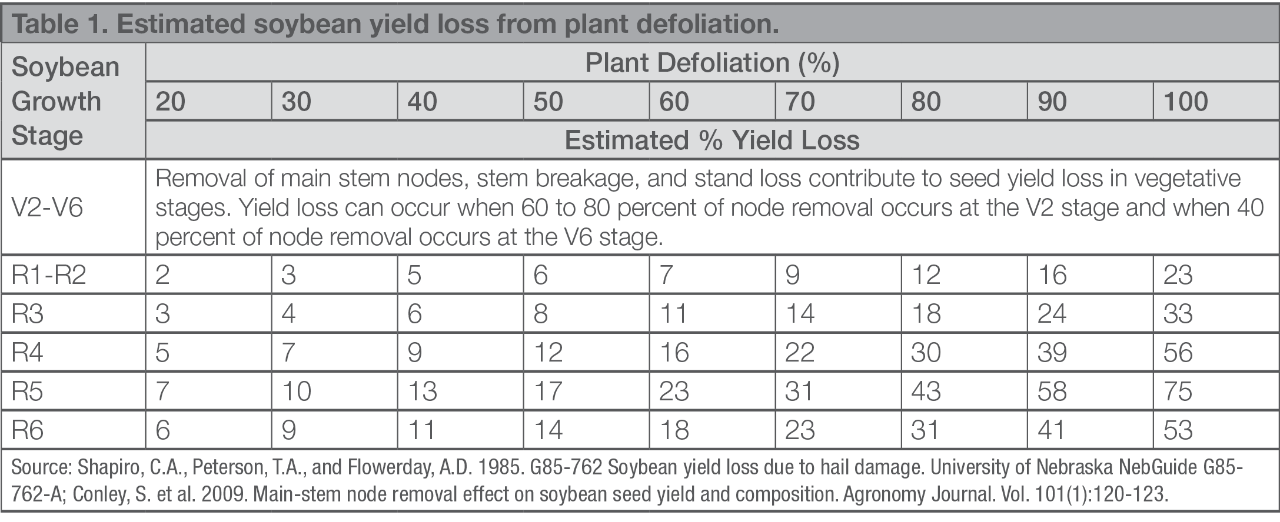Assessment
After a hailstorm, potential yield loss in a soybean crop can result from (1) leaf area reduction, (2) plant bruising, or (3) stand loss. The severity of each of these factors is important to accurately assess the extent of hail damage and how yield potential will likely be affected. Depending on the timing and growth habit of soybeans, there is a good chance for soybean plants with growing points still intact to make a full recovery.
It takes about 4 to 7 days to see regrowth on soybeans after hail. Evaluating the health of the growing point can be done soon after the storm, but to more accurately assess potential yield loss from hail, soybean plants should be evaluated 7 to 10 days after the storm.1 At that time, it should be possible to more accurately distinguish between living plants and plants unable to withstand the hail damage itself or subsequent disease infection.
If the soybean crop was damaged before flowering, plants may not be significantly affected by loss of leaf area (Table 1). Soybean plants have an extraordinary ability to compensate for damaged leaves or reduced stands. If either the stem apex (growing point at the top) or axillary buds (located at the juncture of the stem and leaves) remain intact after the hail event, new branches and leaves can be produced even though the hail may have destroyed nearly all the above-ground foliage (Figure 1).


Leaf damage usually looks worse than it really is, especially in the first few days after the storm passes. Shredded leaves that remain green and attached to the plant will often continue to produce photosynthates (Figure 2). Additionally, soybean loss estimates can be complicated because potential effects of lower stem bruising (which may lead to lodging later in the growing season) can be difficult to evaluate. Bruising may also allow an avenue for infection, which can affect plant health and productivity.

Stand Losses
Because soybean plants have the ability to recover by branching out after a hail event, potential yield loss from stand reduction during early growth stages is not of major concern. If severe stand losses occur, replanting may be a viable option. Fields with a uniform stand of 90,000 plants per acre may realize full yield potential.
Estimating Potential Yield Loss
Defoliation, stand loss, plant bruising, possible disease infection of damaged plants, lodging later in the season, and environmental conditions during the remainder of the growing season are factors involved in estimating potential yield loss. Generally, soybean varieties with determinate growth have less opportunity to compensate for flower and pod loss and could be at greater risk for yield loss from defoliation in later vegetative stages.2
Growers should scout for bacterial diseases, stem rot, and other foliar diseases after a hail event.3 Fungicide application cannot recover yield potential lost due to hail damage; however, application of fungicide either shortly before the hail event or very soon after could limit the negative effects of hail damage. A fungicide, such as Delaro® 325 SC, can increase the plant's stress tolerance after a hail event. Fungicides help fight fungal pathogens that readily feast on weak and/or dead plant tissue caused by hail damage. Additionally, the strobilurin component of Delaro boosts the formation of callus tissue which helps heal wounded plants, creating a barrier that could enhance the recovery and preserve plant productivity.
Delaro® 325 SC fungicide is labeled for managing diseases such as frogeye leaf spot, brown spot, white mold and aerial blight. Consider forecasted conditions, soybean growth stage, and disease presence before applying a fungicide. To learn more about Delaro® fungicide, please visit https://www.cropscience.bayer.us/products/fungicides/delaro and contact your retailer.
Additionally, soybean fields should be scouted for lodging due to weakened stems and rot. Late-season weed flushes can also be a concern due to increased light penetration in defoliated areas. Expected yield loss figures due to damaged or missing plants are only estimates. True yield loss from a hailstorm cannot be fully determined until harvest.
Sources
1Shapiro, C.A., Peterson, T.A., and Flowerday, A.D. 1985. Soybean yield loss due to hail damage. University of Nebraska NebGuide G85-762.
2Ciampitti, I. and Roozeboom, K. 2014. Assessing hail damage on soybeans. K-State Research and Extension. Issue 459.
3Markell, S., Friskop, A., and Ransom, J. 2016. Fungicide use on hail damaged corn and soybeans. North Dakota State University. ag.ndsu.edu
Conley, S., Pedersen, P., and Christmas, E.P. 2009. Main-stem node removal effect on soybean seed yield and composition. Agronomy Journal. Vol. 101(1):120-123.
Pedersen, P. 2004. Soybean growth and development. Iowa State University Extension. PM 1945.
Web resources verified 4/25/2020. 5015_S1
